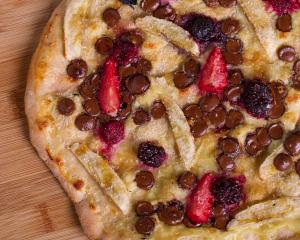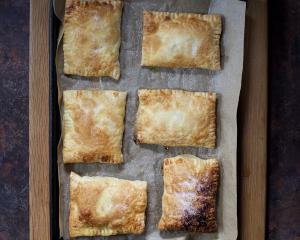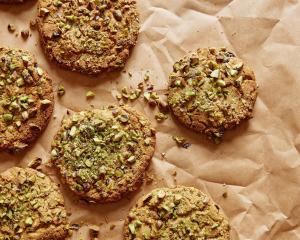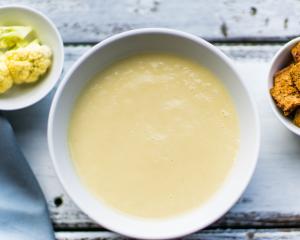
The Australian blogger, food stylist and photographer loves her food but has had ongoing issues with digestion and stomach problems since she was young.
After much angst, medical tests and visits to an integrative doctor, she finally had her digestive issues confirmed.
Her doctor then suggested she try a low-Fodmap diet - restricting foods such as onion, garlic, dairy, fructose and wheat gluten - as a way of managing her symptoms, although she admits it has not cured her.
''I'm still sick, near daily, and it impacts most aspects of my life.''
It means that every meal she eats is a ''highly considered'' decision.
''So I'm not healed, but what the low-Fodmap diet has given me is a framework around which to base my food choices.''
McDermott has shared much of her journey and cooking experiments on a blog and on instagram. Her book, Fodmap Friendly, is an extension of this, she says.
''I hope this book will be helpful for people who are struggling with digestive issues, who are new to Fodmaps, or who still believe that a bill of health isn't worth having to lose entire food groups and flavours from their diet.
''I've been all three of those people.''
As everyone's digestive issues are extremely personal and their reactions to foods different, she suggests if something does not bother a person, eat it, if something else makes them nauseous, leave it out.
''This book will hopefully provide you with ideas and inspiration to experiment with a way of eating that suits you.''
So as well as some basic information on a Fodmap diet and ingredients she includes recipes for breakfasts, lighter dishes, ''grown-up'' dinners, grab and go baking and sweet things.
She also notes she is pescatarian, so her recipes do not include meat, but as it is Fodmap-friendly, it can be added to suit.
 Photos: Supplied
Pumpkin and ricotta gnocchi
Photos: Supplied
Pumpkin and ricotta gnocchi

People commonly lament the inability to find good bread once they've gone gluten-free, but I find that gnocchi takes an equally devastating hit. Ricotta, although not overtly Fodmap-friendly for the dairy intolerant, lends a lovely softness to gnocchi that is almost always lacking in the store-bought variety.
Serves 6
Ingredients
250g (1 cup) pumpkin puree
300g fresh ricotta
100g (¾cup) potato flour
½ cup fine brown rice flour
60g (½ cup) millet flour
¾ tsp fine salt
¾ tsp ground nutmeg
1 egg, lightly beaten
To serve
butter
a handful of fresh sage leaves, chopped or whole
parmesan, freshly grated
Method
1. Combine the pumpkin puree and ricotta in a blender and blend until smooth. Transfer to a large bowl, and add the remaining ingredients. Mix thoroughly until a wet dough has formed. Place plastic wrap over the surface of the dough to prevent a crust from forming, and refrigerate for at least an hour.
2. Line a baking tray with baking paper and ensure your work bench is clean, dry and really well floured (see note).
3. Take the mixture out of the fridge to shape into gnocchi. You can roll it into a thin log and chop the gnocchi into pieces from there (as pictured) or you can simply create little balls with your hands and flatten them into circular gnocchi pieces. Place the gnocchi onto the lined tray as you go and then place it back in the fridge to firm up for 30 minutes.
4. Bring a large saucepan of salted water to the boil, and use a slotted spoon to lower the gnocchi pieces into the water in batches. Make sure not to overcrowd the saucepan; I find it best to cook about 10 pieces at a time. Allow them to cook for an additional couple of minutes after they rise to the surface, and then use the slotted spoon to transfer them from the water to a sieve, to drain. Repeat until all the gnocchi is cooked.
5. To serve, heat the butter and cook the sage leaves in a frying pan over a medium heat, until the butter begins to brown and the leaves get a little crispy. Add the drained gnocchi to the pan, and fry until they have golden, crunchy edges. Serve with a sprinkling of salt and pepper, some freshly grated parmesan, and top with any crispy sage left in the pan.
Note: I use rice flour for my bench - it doesn't add chewiness or stretch like tapioca flour does.
 Pumpkin curry sauce
Pumpkin curry sauce

Think of this recipe as your Fodmap-friendly, not-rubbish equivalent to a jar of curry sauce. The pumpkin lends a sweetness to the sauce, effectively removing the need for onion.
You can add whatever else you'd normally add to your curry, but I've included my go-to ingredients below.
Serves 4
Ingredients
500g pumpkin, peeled and diced into 2.5cm pieces
3-4 Tbsp vegetable oil
4 tsp garam masala
2 tsp ground cumin
1 tsp ground turmeric
½ tsp ground cinnamon
5g-10g fresh ginger, finely grated
270ml tin coconut milk (make sure it doesn't contain inulin)
225g packet tempeh, diced (see note)
500g vegetables of your choice, roughly chopped (I like to use zucchini and pak choy)
fresh chilli, finely chopped, to taste
Method
1. Using your preferred method, steam the pumpkin cubes until soft and well cooked. Set aside.
2. In a large frying pan, heat the vegetable oil over a medium heat and, once warmed, add the spices. Cook for a minute or so until aromatic, and then add the grated ginger.
3. Add the steamed pumpkin to the pan and continue cooking for a few minutes, until the pumpkin is well coated in spices and completely softened.
4. Tip the pumpkin mixture into your food processor (make sure you get all the spices). Allow it to cool for a few minutes (so it doesn't explode on you) and then blitz until the mixture is completely smooth.
5. Put the frying pan back over a medium heat and add a splash of vegetable oil. Return the pumpkin mixture to the pan, add the coconut milk and stir thoroughly. Add the tempeh and your vegetables of choice, and cook until the vegetables are soft.
6. Serve as is, with some freshly chopped chilli sprinkled on top, or with rice.
Note: You can save some of the diced tempeh to use as a garnish if you like. Fry it lightly in oil until nice and crispy, then sprinkle on top for a little crunch.
Pumpkins
- Choose firm pumpkins and squash that have undamaged skin and feel heavy for their size. Select mature pumpkin and squash; they will be shiny or slightly slippery to feel, while an immature one will be slightly sticky. Another indication is brown flecks (or corking) on the stem the more flecks, the more mature.
- Store in a cool, dark, dry place. Once cut, scoop out the seeds, wrap the flesh in plastic film and refrigerate.
- Bake, boil, steam, microwave, roast, stew, stuff.
- Pumpkins and squash are a good source of vitamin A, containing high levels of the carotenoids which the body converts to vitamin A
- Pumpkin and squash are interchangeable and can be used in similar recipes.
— Source: vegetables.co.nz












